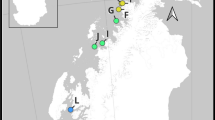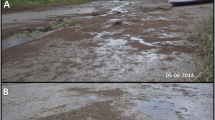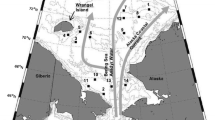Abstract
The seasonality of Arctic climate has a pronounced influence on marine ecosystems. The spring bloom is known to be especially important to the structure of Arctic marine ecosystems, yet comparatively little is known about activity during winter. Previously, analysis of diatom-derived highly branched isoprenoid (HBI) lipids has provided useful data on organic carbon inputs to Arctic ecosystems during spring and summer. Here, we aimed to determine whether these lipids and their sources could also be identified during winter and whether HBI distributions in heterotrophs could be linked to seasonal food supply. A selection of heterotrophs was obtained from the water column as part of the Polar Night Cruise in Rijpfjorden during January 2012, and the sea ice-specific biomarker IP25 and other HBIs were identified in the majority of these. IP25 and other HBIs were also detected in some sediments collected at the same time, but were absent from sea ice and seawater samples. However, analysis of algal cultures from each environment provided some information on the likely origin of the HBIs in sediments and heterotrophs. The similarity of the HBI distributions in sediments and some heterotrophs provides some evidence for benthic feeding during winter, although an alternative explanation involving retention of HBIs from previous spring/summer feeding cannot be discounted at this stage. More information on HBI residence times in heterotrophs is required before these two explanations can be distinguished. Nevertheless, the analysis of HBI lipids would appear to have potential in providing novel information regarding Arctic ecosystems during winter.




Similar content being viewed by others
References
Ambrose WG, Carroll ML, Greenacre M, Thorrold SR, McMahon KW (2006) Variation in Serripes groenlandicus (bivalvia) growth in a Norwegian high- Arctic fjord: evidence for local- and large-scale climatic forcing. Glob Chang Biol 12:1595–1607. doi:10.1111/j.1365-2486.2006.01181.x
Arrigo KR, Mock T, Lizotte MP (2010) Primary producers and sea ice. In: Thomas DN, Dieckmann GS (eds) Sea ice, 2nd edn. Blackwell Publishing Ltd, Oxford, pp 283–325
Backhaus J, Wehde H, Hegseth EN, Kämpf J (1999) Phyto-convection: the role of oceanic convection in primary production. Mar Ecol Prog Ser 189:77–92. doi:10.3354/meps189077
Belt ST, Müller J (2013) The Arctic sea ice biomarker IP25: a review of current understanding, recommendations for future research and applications in palaeo sea ice reconstructions. Quat Sci Rev (in press). doi:10.1016/j.quascirev.2012.12.001
Belt ST, Cooke DA, Robert JM (1996) Structural characterisation of widespread polyunsaturated isoprenoid biomarkers: a C25 triene, tetraene and pentaene from the diatom Haslea ostrearia Simonsen. Tetrahedron Lett 37:4755. doi:10.1016/0040-4039(96)00926-4
Belt ST, Allard WG, Massé G, Robert JM, Rowland SJ (2000a) Highly branched isoprenoids (HBIs): identification of the most common and abundant sedimentary isomers. Geochim Cosmochim Acta 64:3839–3851. doi:10.1016/S0016-7037(00)00464-6
Belt ST, Allard WG, Massé G, Robert JM, Rowland SJ (2000b) Important sedimentary sesterterpenoids from the diatom Pleurosigma intermedium. Chem Commun pp 501–502. doi: 10.1039/a909670a
Belt ST, Massé G, Allard WG, Robert JM, Rowland SJ (2001a) C25 highly branched isoprenoid alkenes in planktonic diatoms of the Pleurosigma genus. Org Geochem 32:1271–1275. doi:10.1016/S0146-6380(01)00111-5
Belt ST, Massé G, Allard WG, Robert JM, Rowland SJ (2001b) Identification of a C25 highly branched isoprenoid triene in the freshwater diatom Navicula sclesvicensis. Org Geochem 32:1169–1172. doi:10.1016/S0146-6380(01)00102-4
Belt ST, Allard WG, Massé G, Robert JM, Rowland SJ (2001c) Structural characterisation of C30 highly branched isoprenoid alkenes (rhizenes) in the marine diatom Rhizosolenia setigera. Tetrahedron Lett 42:5583–5585. doi:10.1016/S0040-4039(01)01063-2
Belt ST, Massé G, Allard WG, Robert JM, Rowland SJ (2002) Effects of auxosporulation on distributions of C25 and C30 isoprenoid alkenes in Rhizosolenia setigera. Phytochemistry 59:141–148. doi:10.1016/S0031-9422(01)00444-7
Belt ST, Massé G, Rowland SJ, Poulin M, Michel C, LeBlanc B (2007) A novel chemical fossil of palaeo sea ice: IP25. Org Geochem 38:16–27. doi:10.1016/j.orggeochem.2006.09.013
Belt ST, Brown TA, Navarro-Rodriguez A, Cabedo-Sanz P, Tonkin A, Ingle R (2012) A reproducible method for the extraction, identification and quantification of the Arctic sea ice proxy IP25 from marine sediments. Anal Methods 4:705–713. doi:10.1039/C2AY05728J
Boetius A, Albrecht S, Bakker K, Bienhold C, Felden J, Fernández-Méndez M, Hendricks S, Katlein C, Lalande C, Krumpen T, Nicolaus M, Peeken I, Rabe B, Rogacheva A, Rybakova E, Somavilla R, Wenzhöfer F, Party RPA–SS (2013) Export of algal biomass from the melting Arctic sea ice. Science 339:1430–1432. doi:10.1126/science.1231346
Brown TA (2011) Production and preservation of the Arctic sea ice diatom biomarker IP25. PhD thesis. Plymouth University, Plymouth
Brown TA, Belt ST (2012a) Identification of the sea ice diatom biomarker IP25 in Arctic benthic macrofauna: direct evidence for a sea ice diatom diet in Arctic heterotrophs. Polar Biol 35:131–137. doi:10.1007/s00300-011-1045-7
Brown TA, Belt ST (2012b) Closely linked sea ice–pelagic coupling in the Amundsen Gulf revealed by the sea ice diatom biomarker IP25. J Plankton Res 34:647–654. doi:10.1093/plankt/fbs045
Brown TA, Belt ST, Philippe B, Mundy CJ, Massé G, Poulin M, Gosselin M (2011) Temporal and vertical variations of lipid biomarkers during a bottom ice diatom bloom in the Canadian Beaufort Sea: further evidence for the use of the IP25 biomarker as a proxy for spring Arctic sea ice. Polar Biol 34:1857–1868. doi:10.1007/s00300-010-0942-5
Brown TA, Belt ST, Piepenburg D (2012) Evidence for a pan-Arctic sea-ice diatom diet in Strongylocentrotus spp. Polar Biol 35:1281–1287. doi:10.1007/s00300-012-1164-9
Brown TA, Bicknell AWJ, Votier SC, Belt ST (2013a) Novel molecular fingerprinting of marine avian diet provides a tool for gaining insights into feeding ecology. Environ Chem Lett (in press). doi:10.1007/s10311-013-0402-x
Brown TA, Belt ST, Ferguson SH, Yurkowski DJ, Davison NJ, Barnett JEF, Jepson PD (2013b) Identification of the sea ice diatom biomarker IP25 and related lipids in marine mammals: a potential method for investigating regional variations in dietary sources within higher trophic level marine systems. J Exp Mar Biol Ecol 441:99–104. doi:10.1016/j.jembe.2013.01.020
Carroll M, Ambrose W (2012) Benthic infaunal community variability on the northern Svalbard shelf. Polar Biol 35:1259–1272. doi:10.1007/s00300-012-1171-x
Conover RJ, Siferd TD (1993) Dark-season survival strategies of coastal zone zooplankton in the Canadian Arctic. Arctic 46:303–311
Eilertsen HC, Degerlund M (2010) Phytoplankton and light during the northern high-latitude winter. J Plankton Res 32:899–912. doi:10.1093/plankt/fbq017
Eilertsen HC, Sandberg S, Töllefsen H (1995) Photoperiodic control of diatom spore growth: a theory to explain the onset of phytoplankton blooms. Mar Ecol Prog Ser 116:303–307
Falk-Petersen S, Sargent JR, Henderson J, Hegseth EN, Hop H, Okolodkov YB (1998) Lipids and fatty acids in ice algae and phytoplankton from the marginal ice zone in the Barents sea. Polar Biol 20:41–47. doi:10.1007/s003000050274
Forest A, Sampei M, Makabe R, Sasaki H, Barber DG, Gratton Y, Wassmann P, Fortier L (2008) The annual cycle of particulate organic carbon export in Franklin Bay (Canadian Arctic): environmental control and food web implications. J Geophys Res 113:C03S05. doi:10.1029/2007jc004262
Forest A, Galindo V, Darnis G, Pineault S, Lalande C, Tremblay J-E, Fortier L (2011a) Carbon biomass, elemental ratios (C:N) and stable isotopic composition (δ13C, δ15N) of dominant calanoid copepods during the winter-to-summer transition in the Amundsen Gulf (Arctic Ocean). J Plankton Res 33:161–178. doi:10.1093/plankt/fbq103
Forest A, Tremblay J-É, Gratton Y, Martin J, Gagnon J, Darnis G, Sampei M, Fortier L, Ardyna M, Gosselin M, Hattori H, Nguyen D, Maranger R, Vaqué D, Marrasé C, Pedrós-Alió C, Sallon A, Michel C, Kellogg C, Deming J, Shadwick E, Thomas H, Link H, Archambault P, Piepenburg D (2011b) Biogenic carbon flows through the planktonic food web of the Amundsen Gulf (Arctic Ocean): a synthesis of field measurements and inverse modeling analyses. Prog Oceanogr 91:410–436. doi:10.1016/j.pocean.2011.05.002
Geoffroy M, Robert D, Darnis G, Fortier L (2011) The aggregation of polar cod (Boreogadus saida) in the deep Atlantic layer of ice-covered Amundsen Gulf (Beaufort Sea) in winter. Polar Biol 34:1959–1971. doi:10.1007/s00300-011-1019-9
Hegseth EN (1992) Sub-ice algal assemblages of the Barents Sea: species composition, chemical composition, and growth rates. Polar Biol 12:485–496. doi:10.1007/bf00238187
Hegseth EN, Svendsen H, von Quillfeldt CH (1995) Phytoplankton in fjords and coastal waters of northern Norway: environmental conditions and dynamics of the spring bloom. In: Skjoldal HR, Hopkins C, Erikstad KE, Leinaas HP (eds) Ecology of fjords and coastal waters. Elsevier Science, Amsterdam, pp 45–72
Hirche H, Kosobokova K (2011) Winter studies on zooplankton in Arctic seas: the Storfjord (Svalbard) and adjacent ice-covered Barents Sea. Mar Biol 158:2359–2376. doi:10.1007/s00227-011-1740-5
Hodal H, Falk-Petersen S, Hop H, Kristiansen S, Reigstad M (2011) Spring bloom dynamics in Kongsfjorden, Svalbard: nutrients, phytoplankton, protozoans and primary production. Polar Biol 35:1–13. doi:10.1007/s00300-011-1053-7
Horner RA, Schrader GC (1982) Relative contribution of ice algae, phytoplankton, and benthic microalgae to primary production in nearshore regions of the Beaufort Sea. Arctic 35:485–503
Jobling M, Johansen SJS, Foshaug H, Burkow IC, Jørgensen EH (1998) Lipid dynamics in anadromous Arctic charr, Salvelinus alpinus (l.): seasonal variations in lipid storage depots and lipid class composition. Fish Physiol Biochem 18:225–240. doi:10.1023/a:1007747201521
Lees J, Nudds R, Stokkan K-A, Folkow L, Codd J (2010) Reduced metabolic cost of locomotion in Svalbard rock ptarmigan (Lagopus muta hyperborea) during winter. PLoS One 5:e15490. doi:10.1371/journal.pone.0015490
Leu E, Søreide JE, Hessen DO, Falk-Petersen S, Berge J (2011) Consequences of changing sea-ice cover for primary and secondary producers in the European Arctic shelf seas: timing, quantity, and quality. Prog Oceanogr 90:18–32. doi:10.1016/j.pocean.2011.02.004
McMahon KW, Ambrose WG Jr, Johnson BJ, Yi Sun M, Lopez GR, Clough LM, Carroll ML (2006) Benthic community response to ice algae and phytoplankton in Ny Ålesund, Svalbard. Mar Ecol Prog Ser 310:1–14. doi:10.3354/meps310001
Morata N, Renaud PE (2008) Sedimentary pigments in the western Barents sea: a reflection of pelagic-benthic coupling? Deep Sea Res Pt II 55:2381–2389. doi:10.1016/j.dsr2.2008.05.004
Morata N, Renaud PE, Brugel S, Hobson KA, Johnson BJ (2008) Spatial and seasonal variations in the pelagic-benthic coupling of the southeastern Beaufort Sea revealed by sedimentary biomarkers. Mar Ecol Prog Ser 371:47–63. doi:10.3354/meps07677
Nansen F (1906) Northern waters: captain Roald Amundsen’s oceanographic observations in the Arctic seas in 1901; with a discussion of the origin of the Northern seas. Dybwad Christiana. doi:10.5962/bhl.title.63719
Noyon M, Narcy F, Gasparini S, Mayzaud P (2011) Growth and lipid class composition of the Arctic pelagic amphipod Themisto libellula. Mar Biol 158:883–892. doi:10.1007/s00227-010-1615-1
Renaud PE, Morata N, Carroll ML, Denisenko SG, Reigstad M (2008) Pelagic-benthic coupling in the western Barents Sea: processes and time scales. Deep Sea Res Pt II 55:2372–2380. doi:10.1016/j.dsr2.2008.05.017
Rowland SJ, Belt ST, Wraige EJ, Massé G, Roussakis C, Robert JM (2001) Effects of temperature on polyunsaturation in cytostatic lipids of Haslea ostrearia. Phytochemistry 56:597–602. doi:10.1016/S0031-9422(00)00434-9
Sampei M, Sasaki H, Forest A, Fortier L (2012) A substantial export flux of particulate organic carbon linked to sinking dead copepods during winter 2007–2008 in the Amundsen Gulf (southeastern Beaufort Sea, Arctic Ocean). Limnol Oceanogr 57:90–96. doi:10.4319/lo.2012.57.1.0090
Sargent JR, Falk-Petersen S (1981) Ecological investigation on the zooplankton community of Balsfjorden, northern Norway: lipids and fatty acids in Thysanoessa inermis (krøyer), Thysanoessa raschii (m.Sars) and Meganytiphanes norvegica (M.Sars) during mid-winter. Mar Biol 62:131–137. doi:10.1007/BF00388175
Sinninghe Damsté JS, Schouten S, Rijpstra WIC, Hopmans EC, Peletier H, Gieskes WWC, Geenevasen JAJ (1999) Structural identification of the C25 highly branched isoprenoid pentaene in the marine diatom Rhizosolenia setigera. Org Geochem 30:1581–1583. doi:10.1016/S0146-6380(99)00140-0
Sinninghe Damsté JS, Muyzer G, Abbas B, Rampen SW, Massé G, Allard WG, Belt ST, Robert JM, Rowland SJ, Moldowan JM, Barbanti SM, Fago FJ, Denisevich P, Dahl J, Trindade LAF, Schouten S (2004) The rise of the rhizosolenid diatoms. Science 304:584–587. doi:10.1126/science.1096806
Søreide JE, Hop H, Carroll ML, Falk-Petersen S, Hegseth EN (2006) Seasonal food web structures and sympagic–pelagic coupling in the European Arctic revealed by stable isotopes and a two-source food web model. Prog Oceanogr 71:59–87. doi:10.1016/j.pocean.2006.06.001
Søreide JE, Falk-Petersen S, Hegseth EN, Hop H, Carroll ML, Hobson KA, Blachowiak-Samolyk K (2008) Seasonal feeding strategies of Calanus in the high-Arctic Svalbard region. Deep Sea Res Pt II 55:2225–2244. doi:10.1016/j.dsr2.2008.05.024
Søreide JE, Leu EVA, Berge J, Graeve M, Falk-Petersen S (2010) Timing of blooms, algal food quality and Calanus glacialis reproduction and growth in a changing Arctic. Glob Chang Biol 16:3154–3163. doi:10.1111/j.1365-2486.2010.02175.x
Stewart DB, Mochnacz NJ, Reist JD, Carmichael TJ, Sawatzky CD (2007) Fish diets and food webs in the northwest territories: Arctic grayling (Thymallus arcticus). Can Manuscr Rep Fish Aquat Sci 2796:vi+21
Sukhanova IN, Flint MV, Pautova LA, Stockwell DA, Grebmeier JM, Sergeeva VM (2009) Phytoplankton of the western Arctic in the spring and summer of 2002: structure and seasonal changes. Deep Sea Res Pt II 56:1223–1236. doi:10.1016/j.dsr2.2008.12.030
Sun M-Y, Carroll ML, Ambrose WG, Clough LM, Zou L, Lopez GR (2007) Rapid consumption of phytoplankton and ice algae by Arctic soft-sediment benthic communities: evidence using natural and 13C-labeled food materials. J Mar Res 65:561–588. doi:10.1357/002224007782689094
Utermöhl H (1958) Zur Vervollkommung der quantitativen Phytoplanktomethodik. Mitt Int Ver Limnol 9:1–39
Volkman JK, Barrett SM, Dunstan GA (1994) C25 and C30 highly branched isoprenoid alkenes in laboratory cultures of two marine diatoms. Org Geochem 21:407–414
Wallace MI, Cottier FR, Berge J, Tarling GA, Griffiths C, Brierley AS (2010) Comparison of zooplankton vertical migration in an ice-free and a seasonally ice-covered Arctic fjord: an insight into the influence of sea ice cover on zooplankton behavior. Limnol Oceanogr 55:831–845. doi:10.4319/lo.2010.55.2.0831
Wassmann P, Reigstad M, Haug T, Rudels B, Carroll ML, Hop H, Gabrielsen GW, Falk-Petersen S, Denisenko SG, Arashkevich E, Slagstad D, Pavlova O (2006) Food webs and carbon flux in the Barents Sea. Prog Oceanogr 71:232–287. doi:10.1016/j.pocean.2006.10.003
Werner I, Auel H, Kiko R (2004) Occurrence of Anonyx sarsi (amphipoda: Lysianassoidea) below Arctic pack ice: an example for cryo-benthic coupling? Polar Biol 27:474–481. doi:10.1007/s00300-004-0616-2
Acknowledgments
We wish to thank the captain and crew of the RV Helmer Hanssen and Stig Falk-Petersen for their assistance in obtaining the samples for this study. We are particularly grateful to Natalie Morata and Emma Michaud for assistance with sediment collection activities and to Tove Gabrielsen and Anna Kubiszyn for assistance in ice core sampling and preparation. Gunilla Eriksen at Univ. Tromso is thanked for her contribution to cell counting and Svein Kristiansen (UiT) for the nutrient analyses. We also thank Plymouth University for providing TB with a fellowship. We also thank three anonymous reviewers for their helpful comments.
Author information
Authors and Affiliations
Corresponding author
Additional information
This article belongs to the special issue ‘Marine Arctic Ecosystems during the Polar Night’, coordinated by Ole J. Lønne.
Rights and permissions
About this article
Cite this article
Brown, T.A., Hegseth, E.N. & Belt, S.T. A biomarker-based investigation of the mid-winter ecosystem in Rijpfjorden, Svalbard. Polar Biol 38, 37–50 (2015). https://doi.org/10.1007/s00300-013-1352-2
Received:
Revised:
Accepted:
Published:
Issue Date:
DOI: https://doi.org/10.1007/s00300-013-1352-2




